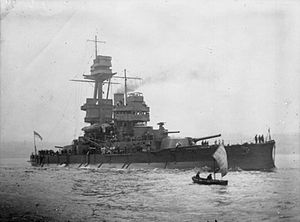 Glatton during World War I
| |
| History | |
|---|---|
| Name | HMS Glatton |
| Builder | Armstrong Whitworth |
| Laid down | 26 May 1913 |
| Launched | 8 August 1914 |
| Commissioned | 31 August 1918 |
| Fate | Wrecked by explosion, 16 September 1918 |
| General characteristics | |
| Class and type | Gorgon-class monitor |
| Displacement | 5,746 long tons (5,838.2 t) at deep load |
| Length | 310 ft (94.5 m) |
| Beam |
|
| Draught | 16 ft 4 in (5.0 m) |
| Installed power | 4,000 ihp (3,000 kW) |
| Propulsion |
|
| Speed | 12 knots (22 km/h; 14 mph) |
| Range | 2,700 nmi (5,000 km; 3,100 mi) at 11 knots (20 km/h; 13 mph) |
| Complement | 305 |
| Armament |
|
| Armour |
|
HMS Glatton and her sister ship Gorgon were originally built as coastal defence ships for the Royal Norwegian Navy, as Bjørgvin and Nidaros respectively. She was requisitioned from Norway at the beginning of World War I, but was not completed until 1918 although she had been launched over three years earlier. On 16 September 1918, before she had even gone into action, she suffered a large fire in one of her 6-inch magazines, and had to be scuttled to prevent an explosion of her main magazines that would have devastated Dover. Her wreck was partially salvaged in 1926, and moved into a position in the northeastern end of the harbour where it would not obstruct traffic. It was subsequently buried by landfill underneath the current car ferry terminal.